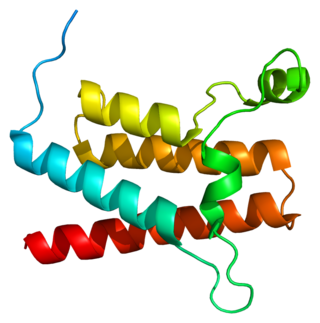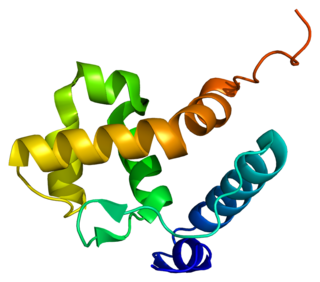
A nucleosome is the basic structural unit of DNA packaging in eukaryotes. The structure of a nucleosome consists of a segment of DNA wound around eight histone proteins and resembles thread wrapped around a spool. The nucleosome is the fundamental subunit of chromatin. Each nucleosome is composed of a little less than two turns of DNA wrapped around a set of eight proteins called histones, which are known as a histone octamer. Each histone octamer is composed of two copies each of the histone proteins H2A, H2B, H3, and H4.
RSC is a member of the ATP-dependent chromatin remodeler family. The activity of the RSC complex allows for chromatin to be remodeled by altering the structure of the nucleosome.
Chromatin remodeling is the dynamic modification of chromatin architecture to allow access of condensed genomic DNA to the regulatory transcription machinery proteins, and thereby control gene expression. Such remodeling is principally carried out by 1) covalent histone modifications by specific enzymes, e.g., histone acetyltransferases (HATs), deacetylases, methyltransferases, and kinases, and 2) ATP-dependent chromatin remodeling complexes which either move, eject or restructure nucleosomes. Besides actively regulating gene expression, dynamic remodeling of chromatin imparts an epigenetic regulatory role in several key biological processes, egg cells DNA replication and repair; apoptosis; chromosome segregation as well as development and pluripotency. Aberrations in chromatin remodeling proteins are found to be associated with human diseases, including cancer. Targeting chromatin remodeling pathways is currently evolving as a major therapeutic strategy in the treatment of several cancers.

Transcription activator BRG1 also known as ATP-dependent chromatin remodeler SMARCA4 is a protein that in humans is encoded by the SMARCA4 gene.

SWI/SNF-related matrix-associated actin-dependent regulator of chromatin subfamily B member 1 is a protein that in humans is encoded by the SMARCB1 gene.

Probable global transcription activator SNF2L2 is a protein that in humans is encoded by the SMARCA2 gene.

Actin-like protein 6A is a protein that in humans is encoded by the ACTL6A gene.

AT-rich interactive domain-containing protein 1A is a protein that in humans is encoded by the ARID1A gene.

SWI/SNF complex subunit SMARCC1 is a protein that in humans is encoded by the SMARCC1 gene.

SWI/SNF-related matrix-associated actin-dependent regulator of chromatin subfamily E member 1 is a protein that in humans is encoded by the SMARCE1 gene.

AT-rich interactive domain-containing protein 1B is a protein that in humans is encoded by the ARID1B gene. ARID1B is a component of the human SWI/SNF chromatin remodeling complex.

SWI/SNF-related matrix-associated actin-dependent regulator of chromatin subfamily D member 1 is a protein that in humans is encoded by the SMARCD1 gene.

The Chromodomain-Helicase DNA-binding 1 is a protein that, in humans, is encoded by the CHD1 gene. CHD1 is a chromatin remodeling protein that is widely conserved across many eukaryotic organisms, from yeast to humans. CHD1 is named for three of its protein domains: two tandem chromodomains, its ATPase catalytic domain, and its DNA-binding domain.

Protein polybromo-1 (PB1) also known as BRG1-associated factor 180 (BAF180) is a protein that in humans is encoded by the PBRM1 gene.

SWI/SNF-related matrix-associated actin-dependent regulator of chromatin subfamily D member 2 is a protein that in humans is encoded by the SMARCD2 gene.
ISWI is one of the five major DNA chromatin remodeling complex types, or subfamilies, found in most eukaryotic organisms. ISWI remodeling complexes place nucleosomes along segments of DNA at regular intervals. The placement of nucleosomes by ISWI protein complexes typically results in the silencing of the DNA because the nucleosome placement prevents transcription of the DNA. ISWI, like the closely related SWI/SNF subfamily, is an ATP-dependent chromatin remodeler. However, the chromatin remodeling activities of ISWI and SWI/SNF are distinct and mediate the binding of non-overlapping sets of DNA transcription factors.
In the field of molecular biology, the Mi-2/NuRDcomplex, is a group of associated proteins with both ATP-dependent chromatin remodeling and histone deacetylase activities. As of 2007, Mi-2/NuRD was the only known protein complex that couples chromatin remodeling ATPase and chromatin deacetylation enzymatic functions.

Diana Hargreaves is an American biologist and assistant professor at The Salk Institute for Biological Studies and member of The Salk Cancer Center. Her laboratory focuses on epigenetic regulation by the BAF (SWI/SNF) chromatin remodeling complexes in diverse physiological processes including development, immunity, and diseases such as cancer.
Robert E. Kingston is an American biochemist and geneticist who studies the functional and regulatory role nucleosomes play in gene expression, specifically during early development. After receiving his PhD (1981) and completing post-doctoral research, Kingston became an assistant professor at Massachusetts General Hospital (1985), where he started a research laboratory focused on understanding chromatin's structure with regards to transcriptional regulation. As a Harvard graduate himself, Kingston has served his alma mater through his leadership.
Cigall Kadoch is an American biochemist and cancer biologist who is Associate Professor of Pediatric Oncology at the Dana–Farber Cancer Institute and Harvard Medical School and an Investigator at the Howard Hughes Medical Institute. Her research is focused in chromatin regulation and how changes in cellular structure can lead to human diseases, such as Cancer, Neurodevelopmental disorders, and others. She is internationally recognized for her work on the mammalian SWI/SNF complex, a large molecular machine known as a Chromatin remodeling complex. She was named as one of the world's leading scientists by MIT Technology Review, 35 Under 35 and Forbes 30 Under 30, and a Finalist for the Blavatnik Awards for Young Scientists. In 2019, she received the Martin and Rose Wachtel Cancer Research Prize from the American Association for the Advancement of Science and in 2020, the American Association for Cancer Research Outstanding Achievement in Basic Cancer Research Award. Kadoch was also recognized as one of the 100 Influential Women in Oncology by OncoDaily.












